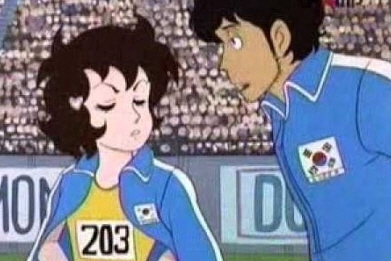Lee Jin-Ju’s Hani mixes multiple genres, including wholesome myungrang manhwa that targets the elementary-school age demographic, 1960s style Korean soonjung manhwa that employs the young female protagonist and family melodrama, and sports manhwa genre that newly established a new pulse of creative enthusiasm in the early 1980s. Additionally, Hani is coloured by the societal tensions seen in 1980s Korea that Lee Hyun-Se’s work alluded to.
The mix of female-protagonist soonjung manhwa with sports manhwa was first seen in Cha Sung-Jin’s 1982 work The Fairy on The Vinyl Record <건반 위의 요정> (please note: this title is my very rough and literal translation of the original title). In an interview with Cha, he describes that watching the 1976 Montreal Winter Olympics gave him the idea to portray the active female. Seeing Nadia Comaneci, a young female Romanian competitor who dominated gymnastics categories with multiple gold medals, Cha noted an athletic female beauty that was different from the attractiveness seen in a Miss Korea. Captivated by the mat, balance beam, and performance, Cha attempted to draw the female not as passive and static, but powerful and precise in movement.
As one of the very few soonjung manhwa artists who produced original work throughout the late 1970s, when plagiarized works dominated the market, Cha began to reject the trope of the weak and pitiful female protagonist, according to Park In-Ha and Kim Nak-Ho. Instead, Cha portrayed a character who rose to stardom, experienced traumatic downfall due to injury, then eventual victory once again after re-attempts at training.
Prior to the 1980s, the rise from failure was not a common theme in manhwa, as narratives, especially in soonjung manhwa, often followed a “good is rewarded, evil is punished” pattern. However, with the appearance of The Fairy on the Vinyl Record and The Alien Baseball Team of Horror in the 1980s, more humanistic and complex narratives involving a star, injury, despair, frustration, and second tries at victory became popular. Sports became the most appropriate source of hope, desire, and the human condition for manhwa during this period.
Choi Yeol posits that Lee Jin-Ju’s protagonist Hani marked the return of the young female protagonist of 1960s Korean soonjung manhwa. Hani and a few other characters had the big sparkly eyes and long legs that recalled the visual style of Candy Candy, but the narrative took place in Seoul and was solidly culturally Korean. Lee Jin-Ju (pen name taken after his daughter), who wrote with an intended audience of elementary-school age children, focused on characters who were outcast, marginalized, and subject to difficult living situations, but were strong-willed nevertheless.



above images taken from the animated TV series (due to copyright, it has so far been impossible to upload the manhwa pages onto this blog. However, I was successful in re-uploading the entire animated TV series in a playlist – see below)
Yeol posits that Hani’s spunky personality and charisma she exuded through her words and behaviour deliver charm and loveliness difficult to find elsewhere in manhwa. In an interview, Lee Jin-Ju revealed that he sourced his characters from real people around him, and based Hani on his wife, Lee Bo-Bae, who was also a soonjung manhwa artist.
When asked whether a Korean identity can be expressed in manhwa despite the heavy imported aesthetics and narratives which have now become a formula, Lee asserted that a work that expresses Korean identity plainly comes down to observing one’s reality, such as one’s neighbours and neighbourhood, and using the observations as source material. Hani thus perhaps takes a step towards the creation of a more authentic and organic soonjung manhwa free from rampant blatant plagiarism.
Run, Hani adapted tv series (1988) Episode 1 (playlist of total 13 episodes)
Compiled from:
Choi, Yeol. The history of Korean cartoons 한국만화의 역사. Seoul: Yeolhwadang, 1995. ISBN 8930126030
Lee, Jin-joo. Run, Hani 1-4. Bada Geurimpan. ISBN 9788955610550, 67, 74, 81. Retrieved from Korean Contents Network, 2010. http://nstore.naver.com/comic/detail.nhn?productNo=43027
Park, In-ha. Nuga Kʻaendi rŭl moham haenna 누가 캔디 를 모함 했나 : 박 인하 의 순정 만화 맛있게 읽기. Seoul: Sallim, 2000. ISBN 8952200438
Run, Hani. Writer Lee Jin-joo, director Lee Hak-bin. KBS/Daiwon Animation, 1988. Retrieved from http://nstore.naver.com/broadcasting/detail.nhn?productNo=1597497
Sohn, Sang-ik. Hanʼguk manhwa tʻongsa (1945 to present) 한국 만화 통사 : 문화사적 관점 에서 본 한국 만화 의 역사 와 이론 : 선사 시대 부터 1945년 까지. Seoul: Sigongsa, 1998. ISBN 8972598739